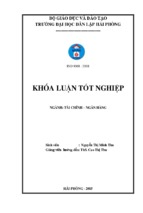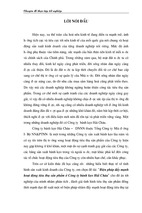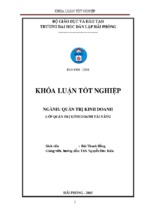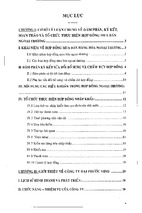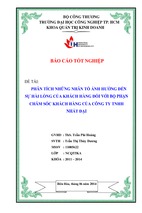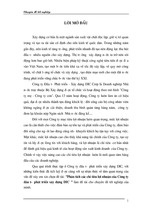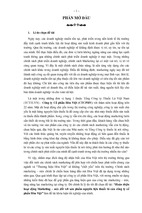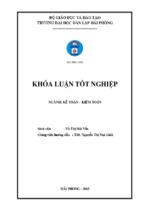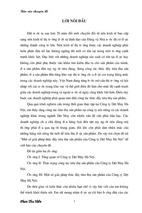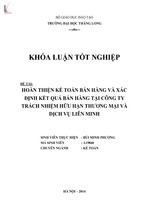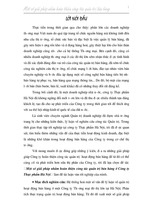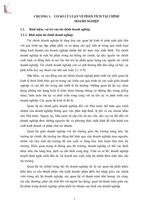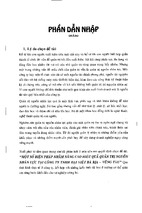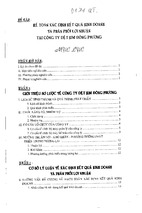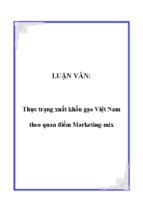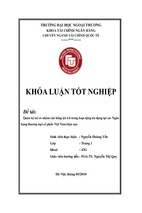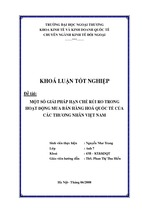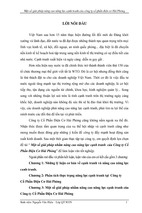Tenacious Women…page 50
Audacious Change…page 84
www.hbr.org
April 2004
62 Hardball: Five Killer Strategies
for Trouncing the Competition
George Stalk, Jr., and Rob Lachenauer
74 The Ambidextrous Organization
Charles A. O’Reilly III and Michael L. Tushman
84 Deep Change: How Operational Innovation
Can Transform Your Company
Michael Hammer
96 When to Walk Away from a Deal
Geoffrey Cullinan, Jean-Marc Le Roux,
and Rolf-Magnus Weddigen
106 Bringing the Market Inside
Thomas W. Malone
18 Forethought
37 HBR Case Study
Losing It
Play
toWin
…page 62
Diane L. Coutu
50 Managing Yourself
Do Women Lack Ambition?
Anna Fels
116 Best Practice
How Fleet Bank Fought Employee Flight
Haig R. Nalbantian and Anne Szostak
127 Tool Kit
Take Command of Your Growth
Michael Treacy and Jim Sims
138 Executive Summaries
144 Panel Discussion
© 2004 United Air Lines, Inc. All Rights Reserved.
Everyone dreams.
Some people are
just more active
participants.
united.com
Inspire, Lead, Inn
Order online at www.harvardbusinessonline.org
From HBS Press
NOW IN PAPERBACK!
Primal Leadership
Learning to Lead with Emotional Intelligence
Daniel Goleman, Richard Boyatzis, and Annie McKee
“Primal Leadership. . . reassesses
what makes a great leader.”
—Time
New York Times and Wall Street Journal
National Bestseller
2004/336 PP/PRODUCT #1849/$14.95/PAPERBACK
Strategy Maps
Converting Intangible Assets
into Tangible Outcomes
Robert S. Kaplan and David P. Norton
From the bestselling authors of The Balanced
Scorecard, Strategy Maps is a blueprint any
organization can follow to align processes,
people, and information technology for
superior performance.
2003/480 PP/PRODUCT #1342/$35.00
The Strategy Map Starter Kit
A Multimedia Toolkit for Firing Up Your Organization
and Putting Strategy Maps to Work
The perfect companion to the Strategy Maps book, this
multimedia toolkit will help you make the case for mapping
strategy in your organization and achieve results.
To learn more, visit: www.bscol.com/hbsp
The Doing Business
Effectively Collection
This collection will teach new
and experienced managers
alike to plan, lead, and innovate
for results. It includes four
Harvard Business Essentials
paperback guides—all at a
savings of more than 10% off
the regular prices.
4 VOLUME SET
PRODUCT #6093BN/$76.00
PAPERBACKS
Harvard Business School Publishing
ovate
Harvard
Business School
Publishing
Specialty
Collections
From Audio
Conferences
Honesty is the Best Strategy
This HBR OnPoint collection offers three
related routes to creating a culture of
honesty—and capturing the vital information you need to translate strategic
promise into reality.
PRODUCT #5917/$16.95
Finding Growth
Through New-Market
Disruption Strategies
In this 90-minute presentation,
Clayton Christensen, author of
The Innovator’s Dilemma, walks you
and your team through the steps to
find new-market growth opportunities for your business.
2003/PRODUCT #533XCD
90 MINUTE CD-ROM/$129
The Results-Driven
Manager Set
Managers are under increasing
pressure to deliver better results
faster than the competition. These
timely guides help managers improve
their performance today and give
them the edge they need—all at a
savings of 10% off the regular prices.
5 VOLUME SET
PRODUCT #6182BN/$67.00/PAPERBACKS
Achieving Strategic
Alignment: Moving from
Promise to Performance
Robert Kaplan and David Norton,
co-authors of The Balanced
Scorecard, conduct an interactive
discussion that identifies the practical, concrete steps that any organization can take to become truly
strategy focused.
2003/PRODUCT #4066CD
90 MINUTE CD-ROM/$129
The Capacity to Lead:
What Makes a Durable
Leader
The Business Fundamentals Series
Collection
Built on recent “background notes” written by
Harvard Business School professors for their MBA
and Executive Education courses, this series
provides the basic skills that every manager
needs—at a savings of over 20%.
Warren Bennis and Robert Thomas,
co-authors of the bestseller Geeks
& Geezers, explore the necessary
steps organizations must take to
identify, develop, and deploy
successful leaders.
2003/PRODUCT #3302CD
90 MINUTE CD-ROM/$129
14 VOLUME SET/PRODUCT #1652BN/$389
www.harvardbusinessonline.org or call 800-668-6780 • Outside the U.S. and Canada: 617-783-7450
HBR
62
Features
106
April 2004
62 Hardball: Five Killer Strategies
for Trouncing the Competition
George Stalk, Jr., and Rob Lachenauer
84
Business has gone soft? It’s high time for companies
to cut the whining about culture and empowerment,
warm up the old pitching arm, and start throwing
the hard stuff that’ll make competitors sweat.
74 The Ambidextrous Organization
Charles A. O’Reilly III and Michael L. Tushman
Big companies can’t pioneer radical innovations – that’s
what some experts say. But a handful of smart companies
are proving them wrong.
84 Deep Change: How Operational Innovation
Can Transform Your Company
Michael Hammer
96 When to Walk Away from a Deal
Geoffrey Cullinan, Jean-Marc Le Roux,
and Rolf-Magnus Weddigen
Operational innovations fuel extraordinary results –
they can destroy competitors and shake up entire
industries. So why aren’t more companies taking
advantage of their power?
Call it deal fever: a highly infectious syndrome that
makes companies blind to the perils of an acquisition.
A few simple but strict rules can keep your mind
clear – and your bottom line healthy – when the urge
to merge appears.
106 Bringing the Market Inside
Thomas W. Malone
The virtues of markets – efficiency, flexibility, motivation – are hard to recreate in the hierarchical confines
of a company. Now, however, technology has made
it possible to have much broader internal markets,
involving people at all levels of the organization.
continued on page 8
COVER ART: MICHAEL MILLER
74
96
6
harvard business review
© 2003 Accenture. All rights reserved.
When faced with new questions,
do you reply with old answers, or new ones?
Go on. Be a Tiger.
There are times when the best shot at success
isn’t the most obvious. To see how we can harness
the power of innovation to help you become a
high-performance business, visit accenture.com
•
Consulting • Technology • Outsourcing
HBR
D e pa r t m e n t s
April 2004
10
FROM THE EDITOR
94
S T R AT E G I C H U M O R
116
BEST PRACTICE
Winning Attitudes
Your employees feel empowered, your
customers are happy, your rivals respect
you – no wonder you’re losing ground.
20
How Fleet Bank Fought
Employee Flight
Haig R. Nalbantian and Anne Szostak
FORETHOUGHT
18 When Good Guanxi Turns Bad
20 Winning the Greenhouse
Gas Game
22 A Network of Invention
24 Mining Gold in Not-for-Profit
Brands
26 Give Me That Real-Time
Information
28 Books in Brief
29
Many companies think the way to retain
employees is to offer them substantial
pay increases. Not Fleet Bank, which
found, upon deeper investigation, that
employees cared more about career
opportunities than they did about pay.
37
Michael Treacy and Jim Sims
Chances are your company is perched
atop potential revenue you can’t see.
A new tool can show you where it is
and how you can capture it.
2 0 0 3 M C K I N S E Y AWA R D S
HBR CASE STUDY
TOOL KIT
Take Command of Your Growth
HBR announces the winners of the
2003 McKinsey Awards.
37
127
134
LETTERS TO THE EDITOR
There may (or may not) be only one
number you need to grow, but is
growth the only goal?
50
Losing It
Diane L. Coutu
Katharina Waldburg, a star performer
at Pierce and Company, seems to be
having an emotional breakdown. She’s
sending rambling, incoherent e-mails
and having inappropriate, unpredictable
exchanges with colleagues. What can –
or should – the company do to help her?
50
MANAGING YOURSELF
138
EXECUTIVE SUMMARIES
144
PA N E L D I S C U S S I O N
Side Defects
Don Moyer
116
Do Women Lack Ambition?
Sometimes side effects yield penicillin;
other times they yield drug-resistant
viruses. Why is it so hard for companies
to anticipate and prepare for unexpected
results?
Anna Fels
Everyone dreams big and hopes
high, and everyone reevaluates those
dreams in the cold light of day. But
women, more than men, not only
reconsider but also abandon their
ambitions. Why’s that? And what
can be done about it?
127
8
harvard business review
FROM THE EDITOR
Winning Attitudes
o T.S. Eliot, April was the
cruelest month. April delivers its
unkindest cut to Bostonians; in this
month, the baseball season begins.
Could the epic agony of the Red Sox,
who haven’t won a World Series since
1918, have motivated George Stalk
and Rob Lachenauer to write this
month’s leadoff article, “Hardball:
Five Killer Strategies for Trouncing
the Competition”? After all, Stalk and
Lachenauer work for the Boston Consulting Group (though Stalk is based
in Toronto). Stalk shares a first name with one George Herman Ruth. And he knows what it takes to win.
You don’t have to know baseball to grasp the difference
between hardball and softball. In “Hardball,” Stalk and
Lachenauer argue – forcefully – that many businesses aren’t
tough enough on their competition. To borrow an image
from another sport, companies pull their punches. They
harvest the fruit of a healthy corporate culture and tend to
their customers with solicitous care. Good things to do! But
no substitute for, and not incompatible with, playing hardball – a game where you don’t shy away from devastating
your competitors’ profit sanctuaries, or from proudly (provided it’s legally) stealing your rivals’ best ideas, or from employing massive and overwhelming force until your adversary cedes the field to you. It’s not the first time Stalk has
exhorted HBR’s readers to compete more vigorously: His
1988 McKinsey Award–winning article “Time – The Next
Source of Competitive Advantage”introduced executives to
a whole new kind of competition. Hardball sounds like
rough stuff, and it is. But it’s also the best way to instill spirit
in your workforce and reignite the sheer fun of being in
business. Southwest Airlines, for example, is a famously hardball competitor – just ask any of its rivals – and a famously
terrific place to work. The airline once ran an advertisement
that said,“We came. We saw. We kicked tail.”
In the spirit of that ad, let me propose that this is, if you’ll
forgive the expression, a kick-ass issue of HBR. Michael
Hammer is back with a powerful new piece,“Deep Change:
How Operational Innovation Can Transform Your Company.” (Hammer is the author of another famous HBR article, “Reengineering Work: Don’t Automate, Obliterate.”)
Hammer takes a swing at an important question: Why is
profound operational innovation so rare? Continuous,
incremental improvements to operations happen, well,
10
continuously. But operational innovation–the kind of change that shifts the
economics of an industry and creates
a competitive advantage that resists
erosion for years–is still so uncommon
you can name practically all the companies that have done it recently: Dell,
Wal-Mart, FedEx, a handful of others.
Hammer describes what operational
innovation looks like, then expertly
probes the obstacles – psychological,
structural, even administrative – that
stand between business as usual and
the kind of deep-down change that allows businesses to
win year after year.
Speaking of winning, don’t miss Anna Fels’s “Do Women
Lack Ambition?”Fels, a New York psychiatrist, probes one of
the troubling mysteries of gender. Young boys and girls are
equally and delightfully unbounded in their ambitions – to
be president, an astronaut, a star athlete, a surgeon. But as
they age, women are more likely than men to abandon their
dreams. These days, that renunciation most often occurs
when a woman reaches her late twenties, when she ought
to be well launched in her career. Why does it happen? Fels’s
article looks at how ambitions are formed, tested, and then
reaffirmed or abandoned. It contains important lessons for
women and their colleagues male and female.
This month, HBR celebrates several winners of its own.
Every year, a panel of extraordinarily accomplished judges
picks what it considers to be the best articles published in
HBR. Please visit page 29 to read about the latest winners
of the McKinsey Award –“AIDS Is Your Business”by Sydney
Rosen, Jonathon Simon, Jeffrey R. Vincent, William MacLeod,
Matthew Fox, and Donald M. Thea; and “The Harder They
Fall” by Roderick M. Kramer. Past McKinsey honorees include Peter Drucker on organizational design, Henry
Mintzberg on the work of the manager, Michael Porter on
competition and strategy, Felice Schwartz on women executives, and, as I noted earlier, George Stalk on speed. It’s a
pleasure to welcome this year’s winners into such distinguished company.
ROBERT MEGANCK
T
Thomas A. Stewart
harvard business review
editor
Thomas A. Stewart
deputy editor
Karen Dillon
executive editor
Sarah Cliffe
art director
Judi Tomlinson
STANFORD
GRADUATE SCHOOL OF BUSINESS
EXECUTIVE EDUCATION
2004 LEADERSHIP AND STRATEGY PROGRAMS
Corporate Governance
June 1 – 4
Executive Program in Leadership:
The Effective Use of Power
July 11 – 16
Executive Program in Strategy and Organization
July 18 – 30
Mergers and Acquisitions
August 15 – 20
Strategic Marketing Management
August 15 – 25
Human Resource Executive Program: Leveraging
Human Resources for Competitive Advantage
September 19 – 24
Leading Change and Organizational Renewal
October 31 – November 5
CHANGE LIVES, CHANGE O RGANIZATIONS, CHANGE
THE
senior editors
Leigh Buchanan
David Champion
Diane L. Coutu
Bronwyn Fryer
Ben Gerson
Paul Hemp
Julia Kirby
Gardiner Morse
Ellen Peebles
Anand P. Raman
senior
production
manager
Dana Lissy
associate
art director
Karen Player
associate
production
manager
Christine Wilder
associate
editor
Eileen Roche
senior designers
Aimee Bida
Jill Manca
consulting
editor
Louise O’Brien
production
coordinator
Josette AkreshGonzales
manuscript
design/production
editors
coordinator
Christina Bortz
Heather Barrett
Lisa Burrell
Roberta A. Fusaro
communications
manager
Margaret K. Hanshaw
Cathy Olofson
Andrew O’Connell
Andrea Ovans
editorial
coordinators
editor for
Kassandra Duane
business
development
Andrew Gray
John T. Landry
contributing
staff
executive editor
and director
Amy L. Halliday
of derivative
Amy N. Monaghan
products
Suki Sporer
Jane Heifetz
editor-at-large,
harvard business school publishing
Walter Kiechel
a note to readers
WORLD
www.gsb.stanford.edu/exed
866.542.2205 (toll free, U.S. and Canada only) or 650.723 .3341
Stanford, California
The views expressed in articles are
the authors’ and not necessarily those of
Harvard Business Review, Harvard Business
School, or Harvard University. Authors may
have consulting or other business relationships
with the companies they discuss.
submissions
We encourage prospective authors
to follow HBR’s “Guidelines for Authors”
before submitting manuscripts. To obtain a
copy, please go to our Web site at www.hbr.org;
write to The Editor, Harvard Business Review,
60 Harvard Way, Boston, MA 02163; or send
e-mail to
[email protected].
Unsolicited manuscripts will be returned
only if accompanied by a self-addressed
stamped envelope.
editorial offices
CHOOSE STANFORD EXECUTIVE EDUCATION FOR PROGRAMS IN:
General Management Financial Management Leadership and Strategy Marketing
Negotiation Technology and Operations Nonprofit and Philanthropy Custom Programs
60 Harvard Way, Boston, MA 02163
617-783-7410; fax: 617-783-7493
www.harvardbusinessonline.org
Volume 82, Number 4
April 2004
Printed in the U.S.A.
n
io ,
at ide
c
u w
Ed ld
e or 03
v
i W 0
ut r –2
ec vide 00
x
E r o 20
P
publisher
Cathryn Cronin Cranston
circulation
fulfillment
manager
Heather McCormick
1
#
direct marketing
manager
Bruce W. Rhodes
manager,
marketing and
operations
Marisa Maurer
senior business
analyst
Adrienne M. Spelker
advertising
production
manager
Catharine-Mary
Donovan
Learning that
Powers Performance®
business
director
Edward D. Crowley
assistant
subscriber
services manager
Elizabeth Sottile
assistant
advertising
manager
Ashley C. Hartmann
worldwide advertising offices
advertising director – worldwide
Trish Henry
212-872-9283
Columbia Executive Education
We set the global
standard for success—for individuals and organizations.
Cutting-edge program designs and an active learning approach create
a
results-oriented environment
unmatched in the world. Our
commitment to our clients’ needs has helped us to achieve the
in executive education for
#1 ranking
four consecutive years
(Financial
Times, 2000–2003). We give you the ideas and tools you need to
power your performance.
UPCOMING COURSES
Marketing Management: Strategies,
Processes and Tools [April 25–30]
Creating Breakthrough Strategy
[June 6–11]
Leading Strategic Growth and Change
[May 2–7]
High Impact Leadership (formerly
known as Leading and Managing
People) [June 6–11]
Executive Development Program: The
Transition to General Management
[May 2–14]
Fundamentals of Management:
Highlights of an MBA [June 13–25]
Negotiation and Decision-Making
Strategies [May 11–13]
The Columbia Senior Executive
Program [June 27–July 23]
New York Maria A. Beacom
Michael J. Carroll
James H. Patten
509 Madison Ave.
15th Floor
New York, NY 10022
212-872-9280;
fax: 212-838-9659
Atlanta
Boston
Chicago
Dallas
Detroit
Los Angeles
San Francisco
Australia
Beijing
France
Hong Kong
India
Japan
Korea
Malaysia
Singapore
Sweden
Taiwan
United Kingdom
404-256-3800
978-287-5400
312-575-1100
214-521-6116
248-524-9000
310-207-4399
415-986-7762
612-9954-3288
86-10-6401-9190
33-01-4643-1630
852-2516-1001
912-2204-8890
81-3-3479-6131
82-2-3702-1790
603-7729-6923
65-6-836-2272
46-8-541-318-37
886-2-2364-9108
44-20-7586-2224
For advertising contact information,
please visit our Web site at
www.hbradsales.com.
subscription service information
u.s. and canada
800-274-3214; fax: 641-842-6101
Rates per year: U.S., $118; Canada, u.s.$128
international
44-1858-438868; fax: 44-1858-468969
Rates per year: u.s.$165; Mexico, u.s.$128
subscribe online
www.hbr.org
reproduction
W W W. G S B . C O L U M B I A . E D U / E X E C E D
800-692-3932 | 212-854-3395
Copyright © 2004 Harvard Business School
Publishing Corporation. All rights reserved.
No part of this publication may be reproduced
or transmitted in any form or by any means,
electronic or mechanical, including photocopy,
recording, or any information storage and
retrieval system, without written permission.
New York Institute of Technology’s fiber optic network
the most of it, NYIT graduated to Xerox multi-
Learn more: www.xerox.com/learn For a sales rep: 1- 800 -ASK-XEROX ext. LEARN
© 2003 XEROX CORPORATION. All rights reserved. XEROX,® The Document Company® and There’s a new way to look at it are trademarks of XEROX CORPORATION.
is one of the fastest on the East Coast. To make
function technology. There’s a new way to look at it.
F o r e t h o u g h t
idea
When Good Guanxi Turns Bad
In China, relationships come first. That’s a problem if your
front line gets too cozy with competitors.
by Wilfried R. Vanhonacker
It would be naive to think – as many Western
executives do – that the more guanxi you have
on the front lines in China, the better. Guanxi,
or personal connection, is powerful stuff, and it
can divide the loyalties of the sales and procurement people your company depends on.
When relationships come first, as they always
do in China, you’d better know who’s friends
with whom.
In the pharmaceutical industry, for example,
it’s not unusual for a Chinese sales rep to sell
drugs on the side from local companies that
compete with his foreign employer. That’s because the rep regards his guanxi not as a company asset but as a personal one that must be developed, protected, and leveraged – and needn’t
be fully revealed to the employer. Selling competitors’ products to local hospital buyers is a
way to pay back favors, fortify guanxi, and bring
in extra cash, all at the employer’s expense. Similarly, Chinese sales reps often seek favorable
credit terms for clients, even when doing so conflicts with company interests, because it enhances the reps’ connections.
Guanxi relationships are defined by a strict
ethic of reciprocity and obligation. Your employees in procurement and sales will always
return favors from guanxi relations, whether the
people they’re paying back are within your company or at competing firms, and they’ll do it
according to their own timetables. In the same
way, a vendor will serve both you and your competitors with complete equanimity because
guanxi permits conflicting relationships as long
as debts (monetary or otherwise) are eventually
settled.
18
Dangerous Liaisons
Because guanxi is so pervasive and powerful,
it’s crucial to understand and manage frontline
employees’ personal networks before they turn
into liabilities. Companies must bring transparency to existing relationships, prevent conflicts of interest from developing, and align employees’ interests with their own. Here’s how
some companies are doing it. They:
Create competition. Ever since the consolidation of its operations in China, multinational
telecommunications provider Alcatel has worked
to restructure its supplier network. Some of its
suppliers were owned by Alcatel shareholders
or partly owned by Alcatel employees; the opportunities for conflict of interest were clear, so
Alcatel introduced a competitive bidding process for all procurements. Without discouraging
employees from cultivating guanxi, Alcatel reduced the chance that their personal connections would be used against the company.
Rotate the front line. One way to shift the
emphasis of business from relationships to
transactions is to periodically (and cautiously)
reconfigure the sales or procurement staff’s client assignments. This disrupts unduly powerful
guanxi connections that can lead employees
astray. Such rotations must be managed gingerly – they can backfire if they are too frequent
or seem arbitrary or punitive. For the U.S. pharmaceutical company Allergan, a postmerger integration provided an opportunity to rotate client assignments without provoking a backlash.
If your company plans to restructure or consolidate its China operations, consider reconfiguring frontline relationships at the same time.
harvard business review

